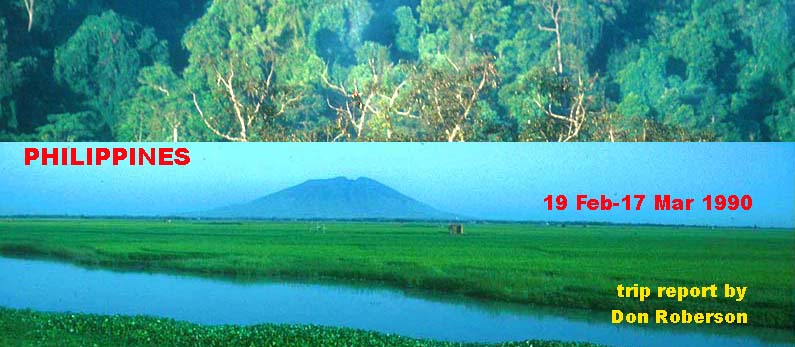

| In 1990 I joined a KingBird Tour to the Philippines. Two years earlier
I had been on a Ben King tour of Sumatra, Java, and Bali, and therefore
on his mailing list. I was persuaded by his annual descriptions of further
habitat loss in the Philippines — and his statement that "If you want to
go, you must go now" — to make it my highest priority. Furthermore, I had
long chosen the Great Philippine (Monkey-eating) Eagle as my most wanted
bird in the world. It seemed paramount to go the Philippines as soon as
I could afford to do so.
Normally I organized my own trips but here I felt a guide and tour group was needed The patchy remaining habitat required much local knowledge; many locales required special permits; the best shot at Philippine Eagle required a camping expedition; and a Philippine insurgency in some areas gave pause. I felt that there was better safety on a tour. So, although Ben King and I had not seen eye-to-eye on some things in Indonesia, I decided to join the Feb-Mar 1990 month-long trip. The price was not too bad ($3574) and I had enough free mileage on United Airlines to round-trip to Manila from my Monterey home for free. It is now (2005) some 15 years later, and I am contemplating a return to the Philippines. I am finally writing up my trip report, as doing so serves as a refresher course and study aid. In retrospect, I am very impressed with the daily journal I kept for a good portion of the 1990 trip, with not only a daily log of events, but detailed descriptions of many species. I wish I had done as well on my notes on other trips. I quote liberally from my field journal on this web page, and in the annotated list. |
||
 The
trip visited five of the main Philippine islands: Luzon, Palawan, Mindanao,
Cebu, and Bohol. [The Philippine Archipelago has 7100 islands, but many
of them are tiny. There are ~10 major islands.] Our main form of transport
was by jeepney (right): colorful, rugged buses. Each one is painted differently;
most have open-air windows. Some Philippine roads were paved and just fine,
but many were dirt and rutted, and got very muddy when in rained. Although
winter is a comparatively 'dry' season, it still often rains in the afternoons
in many tropical locales. The
trip visited five of the main Philippine islands: Luzon, Palawan, Mindanao,
Cebu, and Bohol. [The Philippine Archipelago has 7100 islands, but many
of them are tiny. There are ~10 major islands.] Our main form of transport
was by jeepney (right): colorful, rugged buses. Each one is painted differently;
most have open-air windows. Some Philippine roads were paved and just fine,
but many were dirt and rutted, and got very muddy when in rained. Although
winter is a comparatively 'dry' season, it still often rains in the afternoons
in many tropical locales.
|
||
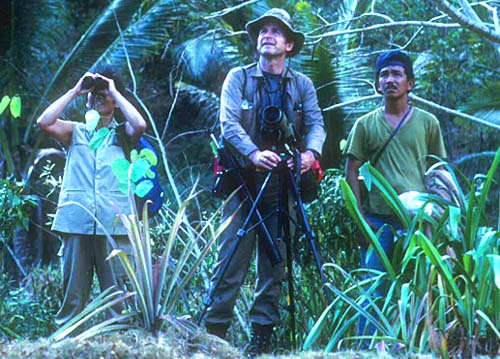 Ben
King was the trip leader but was often joined by local guides from spot
to spot. We used Tim Fisher's tented camp on Mt Katanglad, and he joined
us there for several days. There were 5 paying customers besides me: John
Minot, Richard Koeppel, Marc Weinberger, Zosima Espino, and Joy Mowat.
In general they were very different types of birders than I am. They were
all content to simply follow King around — the two women especially stayed
right at his side at all times (there's one to his left in this shot; Ben
King in the center and then a local guide) — and none were interested in
learning the details of i.d., or to debate taxonomy and taxonomic philosophies,
or to do much more than check off life birds on their list. I remember
trying to explain the i.d. of Long-toed Stint to Mowat (who lives in Toronto)
and comparing it to Least Sandpiper, but she did not know the features
of Least Sandpiper well enough to follow my discussion. She wasn't even
sure what a Least Sandpiper looks like, despite their status as a common
migrant in Ontario. In contrast to them, I wanted to find my own birds
wherever possible, and therefore wanted to go off alone when it could be
arranged. King was tolerant of this for a while but grew less so. He also
refused to discuss any bird I found on my own, and would not add them to
the nightly list. He and I did not hit it off real well. On the other hand,
I got along very well with Tim Fisher and had a wonderful time birding
with him and Marc Weinberger on Mt Katanglad. Ben
King was the trip leader but was often joined by local guides from spot
to spot. We used Tim Fisher's tented camp on Mt Katanglad, and he joined
us there for several days. There were 5 paying customers besides me: John
Minot, Richard Koeppel, Marc Weinberger, Zosima Espino, and Joy Mowat.
In general they were very different types of birders than I am. They were
all content to simply follow King around — the two women especially stayed
right at his side at all times (there's one to his left in this shot; Ben
King in the center and then a local guide) — and none were interested in
learning the details of i.d., or to debate taxonomy and taxonomic philosophies,
or to do much more than check off life birds on their list. I remember
trying to explain the i.d. of Long-toed Stint to Mowat (who lives in Toronto)
and comparing it to Least Sandpiper, but she did not know the features
of Least Sandpiper well enough to follow my discussion. She wasn't even
sure what a Least Sandpiper looks like, despite their status as a common
migrant in Ontario. In contrast to them, I wanted to find my own birds
wherever possible, and therefore wanted to go off alone when it could be
arranged. King was tolerant of this for a while but grew less so. He also
refused to discuss any bird I found on my own, and would not add them to
the nightly list. He and I did not hit it off real well. On the other hand,
I got along very well with Tim Fisher and had a wonderful time birding
with him and Marc Weinberger on Mt Katanglad. |
||
|
||
| In 1990 there was no decent field guide for the Philippines. We all used duPont's (1971) Philippine Birds. It is a big bulky book with a few color plates here and there, most of them very bad, and very brief descriptions of i.d. and status/distribution. I also had the much olden Delacour & Mayr (1946) Birds of the Philippines, which had descriptions and old-fashioned 'keys,' but no plates. A book by Gonzales & Rees (1988) called Birds of the Philippines covered only some selected common species and the headline rarities; it had amateurish art but did have updated checklist in the back from Dickinson, Fisher et al., set out by islands or island groups. Ben King provided us with his own checklist for our trip. He had split quite a number of species, usually on vocalizations (and usually for very good reasons) and made some innovations as to common names. He coined the name "Ibon" for some non-Zosterops white-eyes, for example. Now, in 2005, there is nice new field guide that looks reasonable good: Kennedy, Gonzales, Dickinson, Miranda & Fisher (2000) A Guide to the Birds of the Philippines. The color plates are uneven, not surprising given the variety of artists, but the text, although short, looks good. It lists all subspecies for the islands but does not usually describe more than one or two. | ||
|
17-18 Feb: Fly from Monterey to San Francisco to Manila for free via United Airlines mileage plan, leaving Saturday morning and arriving Sunday night at 11:30 p.m. 19 Feb: A day without transportation awaiting the arrival of the KingBird Tour (to get my free flight, I had to arrive a day early). I walked across the street from the Hyatt on Manila Bay to paddies, fish ponds, and bay edge. It was extremely grotty and dirty with human waste littering the cement causeway holding back the Bay. I worked on large Acrocephalus (eventually figured out as Oriental Reed-Warbler, a common migrant here); a wagtail (proved to be ocularis White Wagtail), got Malay Plover, and saw Brown Shrike and a male Siberian Rubythroat in duff scrub. The tour group arrived in afternoon, and we all had dinner at the Hyatt. 20 Feb: Early morning (0630-0900) visit to the American War Cemetery
in Manila. A fairly birdy place. My notes focus on swiftlet i.d., a Large
Hawk-Cuckoo that flew right over my head; and details of a migrant Brown-headed
Thrush.
below: egrets in mangroves at high
tide on Palawan. I believe most are
Chinese Egrets, slightly larger than the few Little Egrets shown in this shot (e.g., a Little is at the 10 o'clock position, above horizon, in right-hand tree). 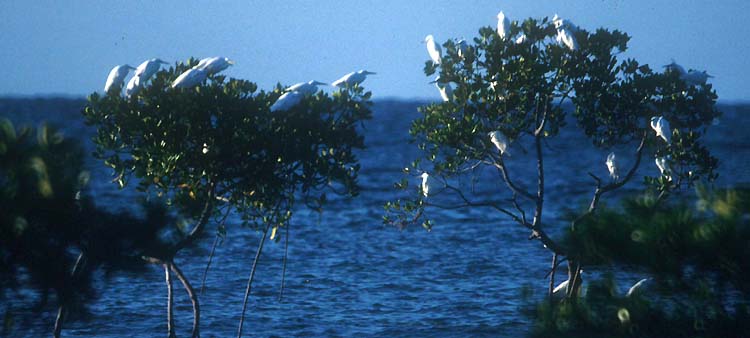 |
||
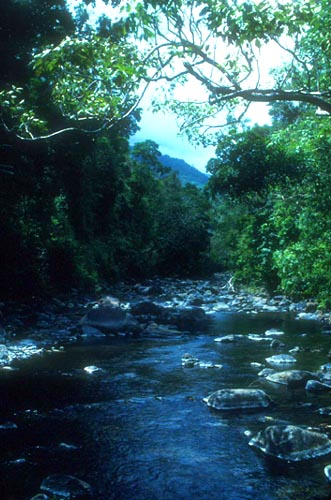 21
Feb: We were up early to Balsahan at 100' elevation at base of hills.
Here we walked a "wonderful trail along a lovely river" (photo right)
and I birded mostly alone. This occurred somewhat by accident when I wandered
ahead of the group that was taking forever to see every bird. I had a great
time alone with 7 endemics including Palawan Hornbill, Palawan Bulbul,
Ashy-headed Babbler, Yellow-throated Leafbird, and Palawan Flowerpecker,
plus Hooded Pitta. I carried my camera, got some pics, found all these
myself, and went skinny-dipping in the river when it got hot. Didn't return
to the group until early afternoon, and we all stayed until 1600. In retrospect
this was one of the best days because it was before Ben King got on my
case about going off alone. 21
Feb: We were up early to Balsahan at 100' elevation at base of hills.
Here we walked a "wonderful trail along a lovely river" (photo right)
and I birded mostly alone. This occurred somewhat by accident when I wandered
ahead of the group that was taking forever to see every bird. I had a great
time alone with 7 endemics including Palawan Hornbill, Palawan Bulbul,
Ashy-headed Babbler, Yellow-throated Leafbird, and Palawan Flowerpecker,
plus Hooded Pitta. I carried my camera, got some pics, found all these
myself, and went skinny-dipping in the river when it got hot. Didn't return
to the group until early afternoon, and we all stayed until 1600. In retrospect
this was one of the best days because it was before Ben King got on my
case about going off alone.
22 Feb: Up at 4 a.m. to get an early start on the Balsahan trail for a 2+ mile march to try for Palawan Peacock-Pheasant with a local guide. Eventually (0900-1100) we heard two; one very close well up a forested ridge after climbing a rocky ravine. But we did not see it, though the male was responding to the tape. This took most of the morning; the real highlight had been the fly-over of a pair of Red-vented (Philippine) Cockatoos. When the group gave up, I stayed on to try some more (but without a tape) and had no luck (but I did see a White-bellied Woodpecker). I had another lovely swim in the river. In the afternoon we visited some fish ponds near Puerto Princesa (many waders plus Painted-Snipe). There was an odd Acrocephalus, but King wasn't interested. 23 Feb: Up at 3 a.m. to get to the Balsahan Penal Colony by 4:30
a.m. for owling. To give him proper credit, Ben King is exceptionally good
at calling in nightbirds with a tape and not turning on the light until
it is sitting right . . . there! He is the best 'owler' I've ever met.
We had great views of Javan Frogmouth and Palawan Scops-Owl.
24 Feb: Up at 3:30 a.m. to catch a 5:20 a.m. flight to Caguyan
de Oro, Mindanao. We then took a bus, later transferred to a jeep, and
finally hiked the short last bit to Tim Fisher's camp at 4500' elev on
Mt Katanglad. As there was an active Great Philippine Eagle nest nearby,
we went to the overlook (the nest was in a huge tree on the far side of
the canyon) and saw the 1.5 month old chick (but no adults this day). Then
heavy rain washed out the rest of the afternoon. We did a bit of owling
after dark; hearing but not seeing Otus mirus.
|
||
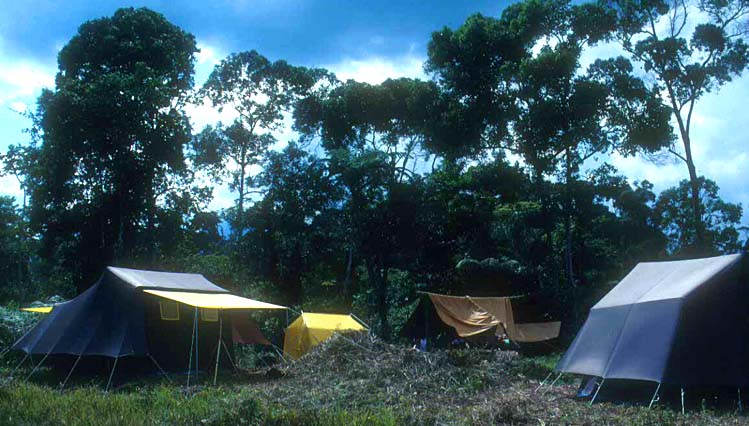 |
||
| An overview of Tim Fisher's camp (above) at ~5000'
elev on Mt. Katanglad.
At the camp (below), Ben King studies duPont's guide, Marc Weinberger works on his notes, while Joy Mowat eats watermelon, and Tim Fisher peaks around far right corner 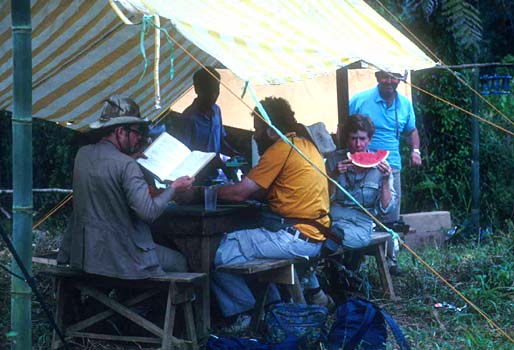 25
Feb: All day birding around Tim Fisher's camp on Mt Katanglad. I spent
a lot of time alone. I hiked from camp (4500') to the river valley (4100')
and back, and then upslope to 4800' elev. Here is a bit from my notes:
"Habitat is much disturbed in the river valley and ridge line. I can hear
chainsaws constantly. It is so depressing. I had the excitement of seeing
the adult Philippine Eagle flap into view, and land on a huge tree, whilst
I was hiking back from the valley. I worked hard to get back to camp, grab
my scope, and get to the lookout, and I was rewarded by seeing the adult
on the nest tearing up something small for the mildly-interested chick.
It didn't stay long but dived down into the forest. Shortly thereafter
it began working the thermals (at 1130 a.m.) up the ravine until is was
soaring at ridge line and away inland towards the higher mountains." 25
Feb: All day birding around Tim Fisher's camp on Mt Katanglad. I spent
a lot of time alone. I hiked from camp (4500') to the river valley (4100')
and back, and then upslope to 4800' elev. Here is a bit from my notes:
"Habitat is much disturbed in the river valley and ridge line. I can hear
chainsaws constantly. It is so depressing. I had the excitement of seeing
the adult Philippine Eagle flap into view, and land on a huge tree, whilst
I was hiking back from the valley. I worked hard to get back to camp, grab
my scope, and get to the lookout, and I was rewarded by seeing the adult
on the nest tearing up something small for the mildly-interested chick.
It didn't stay long but dived down into the forest. Shortly thereafter
it began working the thermals (at 1130 a.m.) up the ravine until is was
soaring at ridge line and away inland towards the higher mountains."
26 Feb: All day birding on Mt Katanglad, mostly alone. I hiked from camp (4500') to the overlook at top of this mountain (5300') and took trail down into river valley in lovely forest (0600-1400). Birdy, but little was new. Good looks at Philippine Serpent-Eagle and Crested Goshawk (sketch and full details in notes). Both today and yesterday I had i.d. problems with small flycatchers (discussion in notes). After dinner the group owled until 2130, and with King's tape & light, got good looks at Philippine Frogmouth. 27 Feb: Up at 0430 for 0515 hike with Tim Fisher & Marc Weinberger
to the mountain-top lookout at 5300' elev. We arrived at 0625, waited until
0830, but still no Apo Starling. We did see the male Great Philippine Eagle
at 0555 on our way up, as it glided down the valley. Then we walked into
the deep woods where I got Flame-crowned Flowerpecker, Snowy-browed Flycatcher,
and Goodfellow's Ibon. Heard a loud jay-like cawing, with tinkling bell-like
notes, which proved to be a long-tailed adult with a just-fledged (still
have gular flanges) juv Apo Starling (sketch in notes). Other evidence
of breeding were both Flame-crowned & Olive-capped Flowerpeckers carrying
nesting material, and fledgling Sulphur-billed Nuthatch & Elegant Tit.
Later saw a Philippine Bullfinch in scope as it ate small fruits.
Rainstorm hits Mt Katanglad camp (below);
rainy weather hindered birding
here, in PICOP forest in eastern Mindanao, and at Rajah Sikatuna NP, Bohol |
||
 28
Feb: Breakfast at Caprice-by-the-Sea Hotel, Caguyan de Oro, then took
11 a.m. flight to Davao. Afternoon (1630-1730) visit to Bagoinigo fish
ponds, near Davao, where I we saw Wandering Whistling-Duck, Philippine
Duck, Asian Palm-Swift, and Yellow Bittern, and I wrote notes on the three
Garganey present. Overnight at Baracatan, where we slept in sleeping bags
in the abandoned research station. 28
Feb: Breakfast at Caprice-by-the-Sea Hotel, Caguyan de Oro, then took
11 a.m. flight to Davao. Afternoon (1630-1730) visit to Bagoinigo fish
ponds, near Davao, where I we saw Wandering Whistling-Duck, Philippine
Duck, Asian Palm-Swift, and Yellow Bittern, and I wrote notes on the three
Garganey present. Overnight at Baracatan, where we slept in sleeping bags
in the abandoned research station.
1 Mar: All day birding at and above Baracatan, a former Philippine Eagle breeding center at 3500' elev in the Apo Range, now abandoned because of NPA guerilla activity. We birded slowly upslope from 3400' to 3700'. Some flocks of basic montane species but not as birdy as the Mt Katanglad area, perhaps because it is very dry. Good views of Striated & Tawny Grassbird in scrub; my notes detail some problems with Phylloscopus i.d. 2 Mar: Apparently we stayed the night at Baracatan again, as
my notes read: "A terrible buffet breakfast at the Apo View Hotel . .
but why aren't we staying here?" The early morning is lost to getting
the jitney repaired. We then drive from 10 a.m. to 5:30 p.m. to reach Bislig
on the east coast of Mindanao. The drive took two extra hours because of
a truck breakdown and a bus stuck in the mud on the direct route, fully
blocking the road and requiring the detour. Virtually no birding except
a brief 5 p.m. stop in the PICOP lowland forest near Bislig. [PICOP is
an acronym for Paper Industries Corporation of the Philippines, and they
have the logging concession to a huge chunk of lowland forest. Logging
roads go everywhere.] Overnight at the Towne & Country Inn which is,
to quote my notes, "a dump." Bislig itself is a muddy port town, your basic
armpit-of-the-world spot.
|
||
Strret scene on muddy main street of downtown Bislig
(below)
 3
Mar: The first of four days birding PICOP forest and vicinity. Each
day we headed out in jitneys along muddy logging roads, often stopping
to walk for an hour or two, and then moving on. The forest is beat up and
birding was often slow. Ben King had tapes but we didn't use that many,
although he did tape in a male Philippine Trogon today. We left at 0430
and returned to Bislig at 1600. My notes say "Thank god! They had to get
a permit." I most have been totally worn out. It was very hot today, with
some rain showers in the morning. Birding from the road we had some nice
birds including a pair of Rufous Hornbill and a pair of Coppersmith Barbet
excavating a nest hole. 3
Mar: The first of four days birding PICOP forest and vicinity. Each
day we headed out in jitneys along muddy logging roads, often stopping
to walk for an hour or two, and then moving on. The forest is beat up and
birding was often slow. Ben King had tapes but we didn't use that many,
although he did tape in a male Philippine Trogon today. We left at 0430
and returned to Bislig at 1600. My notes say "Thank god! They had to get
a permit." I most have been totally worn out. It was very hot today, with
some rain showers in the morning. Birding from the road we had some nice
birds including a pair of Rufous Hornbill and a pair of Coppersmith Barbet
excavating a nest hole.
4 Mar: Returned to PICOP forest, 20 km south of Bislig (1000-1800' elev) from 0600-1300. Today we went back to the Towne & Country for lunch, and then visited nearby rice paddies and marsh from 1600-1800. 5 Mar: Another day in PICOP forest: "very poor birding in hot, dusty weather in badly cut-over secondary forest." Did see the Pygmy Babbler in a canopy flock. Late afternoon visit to the Bislig marshes again, where King paid four local boys to flush birds. In this manner we saw a pair of Watercock, a Wandering Whistling-Duck (off nest?), many Painted Snipe, Grass Owl, and several Swinhoe's Snipe (as well as Common Snipe). 6 Mar: A final morning in the PICOP forest, 20 km south of Bislig (0550-1130). It started to rain by mid-morning as we stopped at the one little pond we had hoped to see Silvery Kingfisher (and missed it again). Birding again rather slow, but King taped in Rufous Paradise-Flycatcher and there were nice scope views of Pink-bellied Imperial Pigeon, Blue-crowned Racquet-tail, and two imm Jerdon's Baza. The rain forced an afternoon drive to Davao, because of the probable cancellation of tomorrow's flight from Bislig (it has only a dirt runway). On the way back to Bislig to get our stuff, two Bush-hen ran across the road for better looks than we had previously had. Also of interest were a male White-bellied Woodpecker working hard at enlarging a nest hole, a nice snoozing water monitor, and a Tarictic Hornbill with a begging youngster (now split as Mindanao Hornbill). The weird Chocolate Hills in the interior
of Bohol (below)
|
||
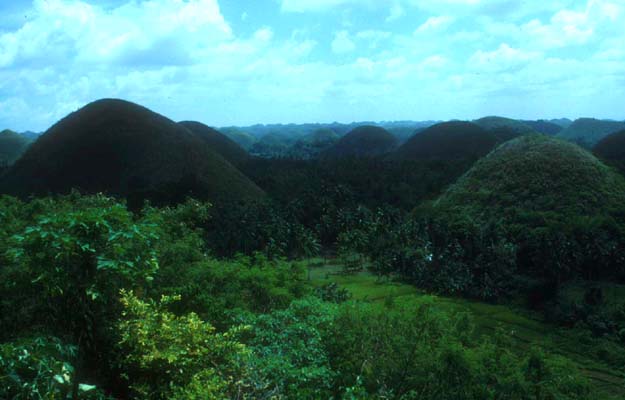 7
Mar: The local travel agent for our tour managed to get us on the early
a.m. flight to Cebu. We arrived at 0800, had breakfast, and were met by
Perlas Magsalay, Philippine coordinator of the Asian Wetlands Bureau. She
is working on the life history and distributional survey of Black Shama.
She and her husband took us to a thicket-lined gully with stands of tall
bamboo. She played the pate and out came the Shama for brief but good views.
King's tape added another views; we then went to another site and called
in another bird. We visited the impressive AWB office in Cebu City, did
a little shopping, and had lunch before a 1640 flight to Bohol. Then a
2.5 hour drive to "hotel" [=dump] in Carman, central Bohol [Chocolate Hills
Resort]. 7
Mar: The local travel agent for our tour managed to get us on the early
a.m. flight to Cebu. We arrived at 0800, had breakfast, and were met by
Perlas Magsalay, Philippine coordinator of the Asian Wetlands Bureau. She
is working on the life history and distributional survey of Black Shama.
She and her husband took us to a thicket-lined gully with stands of tall
bamboo. She played the pate and out came the Shama for brief but good views.
King's tape added another views; we then went to another site and called
in another bird. We visited the impressive AWB office in Cebu City, did
a little shopping, and had lunch before a 1640 flight to Bohol. Then a
2.5 hour drive to "hotel" [=dump] in Carman, central Bohol [Chocolate Hills
Resort].
8 Mar: All day at Rajah Sikatuna Nat'l Park, 3 km east of Bilar, Bohol (except a mid-day return to the hotel for lunch). We birded 0545-1200 and 1600-1930. The elevation here is ~1100'. There was a fruiting tree at the clearing attracting Pompadour Green Pigeons and Philippine Cuckoo-Doves off and on all day. I had good success in the forest on trails that I birded alone. I saw Red-breasted Pitta, a real 'wild' Red Junglefowl, and Rufous-tailed Jungle Flycatcher. After dark, Ben King taped in a pair of Philippine Boobooks. 9 Mar: Another day at Rajah Sikatuna NP (0545-1230; 1600-1830).
Intermittent heavy rain in morning. Very little new. Did see the Rufous-tailed
Jungle Flycatcher again, and eventually everyone saw it; Ben King recorded
its song at dusk. Worked out Arctic Warbler and Chinese Goshawk.
10 Mar: Final morning (0545-0900) visit to Rajah Sikatuna NP.
I hit a flock up on a ridge with monarchs, Black-crowned Babbler, and Rufous-fronted
Tailorbirds. Also saw a Black-faced Coucal, and the Red-breasted Pitta
again (but no Steere's Pitta . . . grrrr). All of which would
have been great, except that the Ben King/Marc Weinberger group saw Wattled
Broadbill on the trial that I took last night!
|
||
| A main road with heavy traffic switchbacks through
the forest at Quezon National Park, Luzon (below) 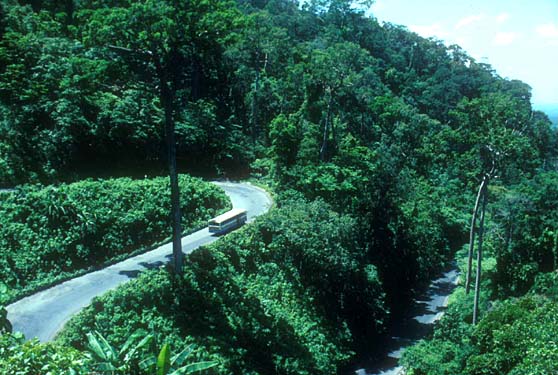 11
Mar: A morning (0600-1100) visit to Mt Makiling where I missed Spotted
Kingfisher by two seconds (saw it fly away). I got one quick head/back/tail
look at a Luzon Bleeding-heart. Ben King taped in a Philippine Hawk-Cuckoo
(his split from Hodgson's; now widely accepted). On Mt Makiling one basically
had a single trail to walk along a river in the forest. Under tour rules,
each person got 5 minutes at the front of the line (behind King) and then
went to the ended and 'worked' your way slowly forward. So you spend a
lot of time looking at watches and your feet. It is a horrible way to bird. 11
Mar: A morning (0600-1100) visit to Mt Makiling where I missed Spotted
Kingfisher by two seconds (saw it fly away). I got one quick head/back/tail
look at a Luzon Bleeding-heart. Ben King taped in a Philippine Hawk-Cuckoo
(his split from Hodgson's; now widely accepted). On Mt Makiling one basically
had a single trail to walk along a river in the forest. Under tour rules,
each person got 5 minutes at the front of the line (behind King) and then
went to the ended and 'worked' your way slowly forward. So you spend a
lot of time looking at watches and your feet. It is a horrible way to bird.
Mid-day drive to Lucena. Later in the afternoon we visited Quezon Nat'l Park at 600' elevation, where we found hardly any birds. There is a main road with heavy traffic right through the middle of the park; there are generally too many people on the trails; and there is air pollution. 12 Mar: An early morning visit to Quezon NP (0530-1145). In the
early morning we walked on a trail inside the forest; after 0830 we birded
a noisy roadside. King refused to give me any parameters within which to
bird alone, thus sabotaging my hopes for more quiet trail birding. He also
snapped when I complained of his twice flushing an interesting thrush (Ashy
Thrush?) before we could identify it. "If you want perfect, Don, you should
start with yourself," he said. He would not explain what that meant.
13 Mar: A final morning (0530-1130) at Quezon NP. Today I was able to bird alone on a forest trail to and past Cuevo Santa, and then spent the rest of the morning on the road. It was good lowland forest but birds were few: hunters (saw 3 yesterday), chainsaws (heard all day long) and pollution (both noise and exhaust along the road) may be the causes. I did have yet another good view of a foraging Red-breasted Pitta, and saw the Luzon Bleeding-heart better, as it walked down the track and into the woods. Nice views of head, back, wing, pinkish sides to breast/flanks, but still didn't see the "heart." Then I had great views of a female Sooty Woodpecker (sketch in notes), a fine species that everyone else missed on the trip. Lunch at Quan's Worth Farms, then afternoon drive to Manila. Overnight Philippine Village Hotel. A sunset photo (below), this one
from Palawan, but weather permitting,
we saw sunrise & sunset every day as we were often up early and up late |
||
 14
Mar: Left Manila at 0415, arriving at Candaba marsh at 0600. Or at
least it was once a marsh; now it is mostly just flooded ag fields. We
birded here for 2 hours and saw a few interesting birds along the much
channeled reed-beds. The most interesting were two Speckled (Spotted) Reed-Warblers
(details in notes). After lunch in San Jose City, we began to climb into
highlands. We stopped several times to scope a river far below us. On one
stop I found a White Wagtail on a sandbar that appeared to show big white
patches in the remiges in flight, strongly suggesting Black-backed Wagtail
M. (alba) lugens. We had been dealing with these taxa in the California
Bird Records Committee, and I knew a lot about the i.d. Lugens was previously
unrecorded in the Philippines. Ben King was not interested; barely glanced
at the bird; couldn't care less that I was on the CBRC; and hustled us
along. So I drew a sketch and wrote details in the moving bus but, in retrospect,
felt that my views had been too brief and inadequate to claim this rarity.
I just let this one go. We later stopped at a bridge over the Ifugoa River,
28 km south of Banaue, and the stop produced a pair of Dwarf River Kingfisher,
which King calls Torrent Kingfisher [and now, in 2005, are known as Indigo-banded
Kingfisher], a pair of Pied Bushchat, and a Blue Rock Thrush. Overnight
in Banaue Hotel in Banaue, a town famous for its terraced rice paddies. 14
Mar: Left Manila at 0415, arriving at Candaba marsh at 0600. Or at
least it was once a marsh; now it is mostly just flooded ag fields. We
birded here for 2 hours and saw a few interesting birds along the much
channeled reed-beds. The most interesting were two Speckled (Spotted) Reed-Warblers
(details in notes). After lunch in San Jose City, we began to climb into
highlands. We stopped several times to scope a river far below us. On one
stop I found a White Wagtail on a sandbar that appeared to show big white
patches in the remiges in flight, strongly suggesting Black-backed Wagtail
M. (alba) lugens. We had been dealing with these taxa in the California
Bird Records Committee, and I knew a lot about the i.d. Lugens was previously
unrecorded in the Philippines. Ben King was not interested; barely glanced
at the bird; couldn't care less that I was on the CBRC; and hustled us
along. So I drew a sketch and wrote details in the moving bus but, in retrospect,
felt that my views had been too brief and inadequate to claim this rarity.
I just let this one go. We later stopped at a bridge over the Ifugoa River,
28 km south of Banaue, and the stop produced a pair of Dwarf River Kingfisher,
which King calls Torrent Kingfisher [and now, in 2005, are known as Indigo-banded
Kingfisher], a pair of Pied Bushchat, and a Blue Rock Thrush. Overnight
in Banaue Hotel in Banaue, a town famous for its terraced rice paddies.
15 Mar: All day (0615-1815) on Mt Polis looking for Luzon montane specialties. We birded along the road on both side of the pass (at 5800' elev.) down to about 5000' on the south side, and down to the river (~4000' elev) on the north side. King taped in Long-tailed Bush-Warbler (insect-like trill) and Cettia seebohmi (Luzon Bush-Warbler, when and if split). We also saw the local race of White-bellied Whistler, Island Flycatcher, and had two fly-over screeching Montane (Red-crowned) Racquet-tails (i.d. primarily on size/shape/call and range, just as for Green-headed Racquet-tail at Quezon NP). The best birds were the Mountain (or Strong-billed) Shrike and a pair of Luzon Redstart (distant photos; sketch in notes). 16 Mar: Morning on Mt Polis (0530-1400), this time on the south slope. In the predawn we got very close to a calling Luzon Scops-Owl but did not see it. King, Weinberger, and Koeppel got glimpses of a Marche's Fruit-Dove in the mists of the morning, but I missed it while sleeping in the van (I am just worn out with this schedule). The rest of day was very boring. We were back to hotel by 1530. Best part of day was shopping at the Banaue rice terrace overlook. [And when shopping is the best part of any day, you know you are really in trouble . . .]. 17 Mar: Final day of trip. Pre-dawn (0300) departure to get a
final try for Luzon Scops-Owl, but the moon was out and we only heard it
deep down the canyon. Later in the morning we ran into a Birdquest tour,
led by Nigel Redman and Tim Fisher, at the fruiting tree near the top of
the road. We waiting here from 0600-0730 but little action, although 2
Spotted Imperial-Pigeons flew over. We did watch a calling Plaintive Cuckoo
give its full repertoire. It was good to meet Nigel (we were to correspond
on various topics later) and see Tim again.
|
||
|
||
| PHOTOS: All photos on this page are © 2005 Don Roberson;
all rights reserved. Many other shots from this trip are scattered about
this web site.
Literature cited: Chantler, P. 2000. Swifts: A Guide to the Swifts and Treeswifts of the World. 2d ed. Yale Univ. Press, New Haven, CT.TOP TO LIST OF BIRD FAMILIES OF THE WORLD |